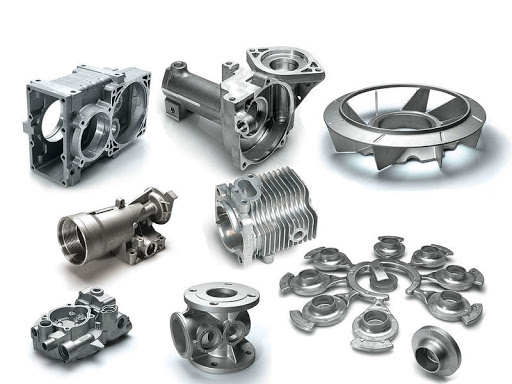Recognizing the Role of Aluminum Foundry in Creating High-Quality Metal Products
Aluminum foundries are vital in the manufacturing of high-grade steel items. They employ various casting strategies, such as sand and die spreading, to achieve accuracy and longevity. With rigorous quality assurance actions in area, these facilities guarantee that their products meet industry standards. As markets evolve, the function of Aluminum factories remains to adjust. This questions about future developments and sustainability practices that might redefine their impact.
The Aluminum Spreading Process: Advancements and strategies
The Aluminum casting procedure has actually developed substantially, incorporating different strategies and developments that improve efficiency and item high quality. Typically, techniques such as sand spreading and die casting were primary; however, developments have actually introduced processes like investment spreading and low-pressure die casting. These developments make it possible for makers to achieve detailed layouts and tighter tolerances, decreasing material waste and improving general performance.
Moreover, the assimilation of computer-aided style (CAD) and simulation software program enables even more accurate modeling and testing, making sure that potential issues are determined early in the production cycle. Furthermore, developments in alloy formulations cause boosted mechanical properties and corrosion resistance
These developments not only improve production however additionally promote sustainability by reducing energy consumption and emissions. As the industry continues to accept brand-new innovations, the Aluminum casting procedure continues to be a crucial component in generating top quality steel products that meet diverse market demands.
Applications of Aluminum in Numerous Industries
Aluminum's versatility and favorable residential properties make it a valuable product across different industries. In the auto industry, Aluminum is commonly used for its light-weight attributes, contributing to improved fuel performance and efficiency. The aerospace industry also benefits, as aluminum's high strength-to-weight proportion improves airplane design while preserving security standards.
In construction, Aluminum is preferred for its sturdiness and resistance to corrosion, making it perfect for window frames, roof covering, and architectural components. The product packaging industry leverages light weight aluminum's safe nature and recyclability, specifically in food and drink containers, making certain security and sustainability.
Additionally, the electric market uses Aluminum for its exceptional conductivity in circuitry and transmission lines. The consumer products field uses Aluminum in products varying from kitchen utensils to electronics, highlighting its flexibility. Aluminum plays a crucial duty in enhancing capability, performance, and sustainability across varied applications.
Advantages of Utilizing Aluminum Over Various Other Steels
While many steels are utilized in numerous applications, Aluminum sticks out due to its unique combination of buildings that provide numerous advantages over other products. Its light-weight nature substantially reduces transportation prices and power usage, making it suitable for industries such as automotive and aerospace. Light weight aluminum's excellent corrosion resistance improves sturdiness, extending the life of items and lowering maintenance requirements. In addition, it exhibits high thermal and electrical conductivity, making it suitable for electrical and thermal administration applications.
The steel's malleability permits elaborate designs and complicated shapes, giving flexibility in manufacturing procedures. Aluminum is 100% recyclable without loss of high quality, promoting sustainability and reducing environmental impact. These attributes, integrated with its reasonably low cost compared to other steels, position Aluminum as a preferred option throughout various industries. Generally, the benefits of Aluminum contribute to its raising appeal in the production of high-grade metal items

High Quality Control Steps in Aluminum Foundries
Quality control procedures play an essential role in the Aluminum Foundry procedure, ensuring that the end products satisfy strenuous market standards and client expectations. These steps usually begin with material examination, where raw Aluminum is examined for pureness and find out this here composition. Once the spreading process starts, temperature control is crucial; maintaining perfect molten metal temperatures avoids issues such as porosity and shrinking.
Furthermore, non-destructive testing (NDT) strategies, consisting of radiographic and ultrasonic inspections, are employed to discover interior imperfections without harming the spreadings. Aesthetic evaluations are likewise conducted at numerous phases to identify surface area blemishes.
Adherence to well established high quality administration systems, such as ISO criteria, is important for preserving uniformity and traceability throughout the manufacturing procedure. Regular audits and employee training Find Out More on top quality criteria add to a general society of excellence, guaranteeing that the items not only go beyond yet meet client assumptions in efficiency and toughness.
The Future of Aluminum Foundries: Fads and Sustainability
As the Aluminum Foundry industry evolves, emerging fads and a focus on sustainability are reshaping its landscape. Increasing need for sturdy and light-weight materials in fields like automotive and aerospace drives innovation in Aluminum spreading methods. Advanced modern technologies, such as expert system and automation, are boosting manufacturing efficiency and accuracy while decreasing waste.
Sustainability is becoming a paramount issue, motivating factories to apply eco-friendly methods, including reusing Aluminum scrap and using sustainable power sources. The shift towards circular economic situation concepts urges foundries to lessen environmental influence while meeting customer expectations for lasting items.
In addition, regulatory stress are pushing the market in the direction of cleaner procedures, fostering collaboration between manufacturers and ecological companies. As these trends merge, the future of Aluminum factories will likely be characterized by a commitment to efficiency, sustainability, and top quality, guaranteeing their relevance in an open market.
Regularly Asked Questions
What Are the Environmental Impacts of Aluminum Foundries?
Light weight aluminum foundries add to ecological effects with power usage, greenhouse gas exhausts, and prospective air and water contamination. Additionally, mining bauxite for Aluminum can bring about environment damage and dirt degradation, influencing local environments.

How Do Factories Make Certain Employee Security Throughout Production?
Shops carry out strenuous safety methods, including protective equipment, ventilation systems, and regular training. They perform threat evaluations and maintain safety and security standards to reduce hazards, ensuring a more secure working environment for employees throughout the manufacturing procedure.
What Qualifications Should a Light Weight Aluminum Foundry Have?
A light weight aluminum Foundry must possess accreditations such as ISO 9001 for high quality monitoring, ISO 14001 for environmental management, and OSHA compliance for security i loved this requirements. These qualifications guarantee adherence to industry regulations and dedication to top quality and security techniques.
Just How Does Aluminum Recycling Affect Foundry Procedures?
Aluminum reusing substantially enhances Foundry procedures by offering a cost-efficient resources resource, reducing energy consumption, and reducing ecological impact - Aluminum Castings. It also encourages sustainable techniques, enabling shops to keep competitiveness in a swiftly progressing market
What Are Usual Problems in Aluminum Castings?
Common issues in Aluminum spreadings consist of porosity, shrinkage, inclusions, and surface area flaws. These issues can arise from inappropriate mold and mildew layout, inadequate putting methods, or contamination during the melting and casting processes, impacting general item top quality.
